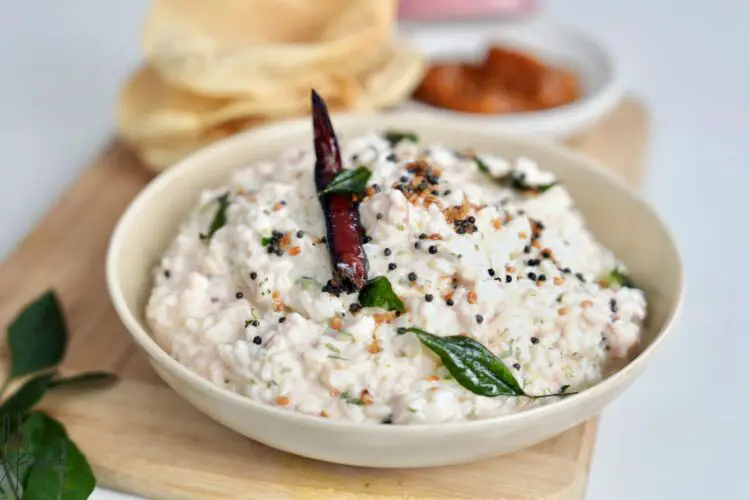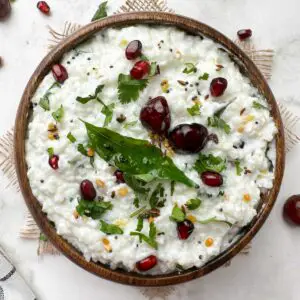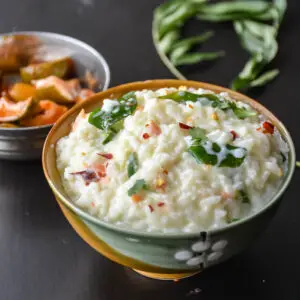Curd rice, also known as yogurt rice or thayir sadam, is a popular dish in South India. It is a simple and comforting rice preparation that combines cooked rice with yogurt and various seasonings. It is often served as a part of a traditional South Indian meal or eaten as a standalone dish.
Curd rice is often served with pickles or papad (thin, crispy disc-shaped snacks). It is a soothing and cooling dish, perfect for hot summer days. Additionally, it is considered to aid in digestion and is often included in meals as a palate cleanser.
Beyond its simplicity and taste, curd rice is also known for its health benefits. Yogurt is a good source of probiotics, which promote a healthy gut and aid in digestion. It is also rich in calcium, vitamins, and minerals, providing nourishment to the body.
Overall, The rice is a beloved dish in South Indian cuisine, loved for its simplicity, versatility, and refreshing taste.
Ingredients for curd rice
- Cooked rice: 1 cup
- Yogurt: 1 cup
- Milk: 1/4 cup (optional)
- Salt: to taste
- For tempering:
- Oil or ghee: 1 tablespoon
- Mustard seeds: 1/2 teaspoon
- Urad dal (split black gram): 1/2 teaspoon
- Curry leaves: a few
- Green chilies: 1-2, finely chopped (optional)
- Ginger: 1/2 inch piece, grated (optional)
- Asafoetida (hing): a pinch
Instructions:
- Start by cooking the rice according to your preferred method. Once cooked, allow it to cool slightly. You can also use leftover rice for this recipe.
- In a bowl, take the yogurt and whisk it until it becomes smooth. If you prefer a creamier texture, you can add milk to the yogurt and whisk until well combined.
- Add the cooked rice to the yogurt and mix well, ensuring that the rice is evenly coated with yogurt. The consistency should be creamy and moist.
- Heat oil or ghee in a small pan over medium heat.
- Add mustard seeds to the heated oil or ghee and let them splutter.
- Once the mustard seeds start spluttering, add urad dal to the pan. Sauté until the dal turns golden brown.
- Add curry leaves, chopped green chilies, grated ginger, and a pinch of asafoetida (hing) to the pan. Sauté for a minute or until the flavors are released.
- Remove the pan from heat and pour the tempering over the curd rice mixture. Mix well to incorporate the tempering throughout the rice.
- Season the rice with salt according to your taste. Remember to start with a small amount of salt and add more if needed.
- At this point, you can let the rice sit for some time to allow the flavors to meld together. If you prefer chilled curd rice, refrigerate it for a couple of hours before serving.
- Serve the curd rice at room temperature or chilled as a standalone dish or as part of a meal. It pairs well with pickles, papad, or vegetable curries.
Serving suggestions
Pair the rice with pickles or chutneys for added tanginess and flavor. You can also Top it with roasted nuts or seeds for a crunchy texture.
Garnish with fresh herbs like coriander or mint leaves for a pop of freshness. Serve alongside papadums or crispy crackers for a satisfying crunch.
Add a side of sliced fruits like pomegranate or grapes for a refreshing twist. Enjoy with a side of vegetable curry or sambar for a complete meal. Drizzle with a little bit of ghee for added richness and flavor.
These serving suggestions can enhance your curd rice and make it even more delicious. Feel free to mix and match according to your taste preferences!
Tips and Variations
Tips:
- Use well-cooked and slightly cooled rice to ensure the curd rice has the right texture and consistency.
- Adjust the amount of yogurt and milk according to your desired creaminess. If you prefer thicker curd rice, use less yogurt or add more rice.
- Ensure the yogurt is whisked well to avoid any lumps and to achieve a smooth texture.
- If you want to make the curd rice ahead of time, mix the rice and yogurt mixture first, and add the tempering just before serving to maintain the freshness of flavors.
Variations:
- Add grated carrots, chopped cucumbers, or finely diced tomatoes to the curd rice for added freshness and crunch. These vegetables can be mixed in along with the yogurt and rice.
- For a fruity twist, add diced pineapple, mangoes, or grapes. It adds a sweet and tangy flavor to the dish.
- To make it more nutritious, you can add cooked and mashed vegetables like peas, corn, or beans. It adds color, texture, and extra nutrients.
- For a herb-infused variation, mix in chopped mint leaves or coriander leaves along with the tempering. It imparts a refreshing aroma and taste.
- For a creamy and rich version, you can add a tablespoon of cream or sour cream to the curd rice.
FAQs
- Can I use non-dairy yogurt?
Yes, you can use non-dairy yogurt made from almond milk, soy milk, or coconut milk to make a dairy-free version of curd rice.
- How long can curd rice be stored in the refrigerator?
Curd rice can be stored in the refrigerator for up to 2-3 days. Make sure to store it in an airtight container.
- Is curd rice suitable for people with lactose intolerance?
People with lactose intolerance can enjoy curd rice by using lactose-free yogurt or yogurt made from non-dairy milk.
- Can I add spices like turmeric or red chili powder?
Traditional curd rice doesn’t include turmeric or red chili powder. However, you can experiment with adding a pinch of turmeric for a subtle yellow color or a dash of red chili powder for a mild spicy kick.
- Is curd rice a good option for a light meal or for weight loss?
Curd rice can be a satisfying and light meal option. It is low in fat and can be made with healthier ingredients. However, portion control is essential, and it’s important to balance rice with a variety of other nutritious foods as part of a well-rounded diet.
Nutrition
| Calories | 215kcal |
| Carbohydrates | 16g |
| proteins | 7g |
| sodium | 113mg |
| potassium | 318mg |
| sugar | 7g |
| Vitamin A | 200IU |
| Vitamin C | 0.4mg |
| Fat | 13g |
| Iron | 0.1mg |



